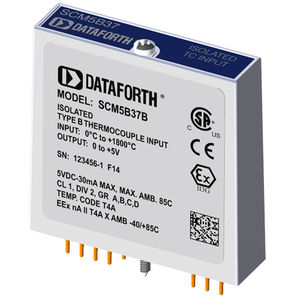
- Robotics - Automation - Industrial IT
- Automation
- Analog input module
- Dataforth Corporation
Thermocouple input module SCM5B37 Seriesanalogprinted circuit board-mounted


















Add to favorites
Compare this product
Characteristics
- Signal type
- analog
- Applications
- for thermocouples
- Mounting
- printed circuit board-mounted
Description
Thermocouple Input Module
Thermocouple Type: B
Output Range: 0 to +5 V
Input Temperature Range: 0 to 1800 °C
Mechanical Format: Modular plug-in-board
Each SCM5B37 non-linearized thermocouple-input module provides a single channel of thermocouple-input which is filtered, isolated, amplified, and converted to a high-level analog voltage output (Figure below). This voltage output is logic-switch controlled, allowing these modules to share a common analog bus without the requirement of external multiplexers.
The SCM5B module family is designed with a completely isolated computer- side circuit which can be floated to ±50V from Power Common, pin 16. This complete isolation means that no connection is required between I/O Common and Power Common for proper operation of the output switch. If desired, the output switch can be turned on continuously by simply connecting pin 22, the Read-Enable pin, to I/O Common, pin 19.
Catalogs
No catalogs are available for this product.
See all of Dataforth Corporation‘s catalogsOther Dataforth Corporation products
SCM5B37-xx NON-LINEARIZED THERMOCOUPLE INPUT MODULES
Related Searches
- Digital master module
- I O module
- Analog master module
- Digital I O module
- Analog I O module
- DIN rail mounted converter
- DIN rail I O module
- Compact master module
- Serial converter
- Communication module
- Compact converter
- Configurable I O module
- Industrial converter
- RS-485 converter
- RS232 converter
- Analog input module
- Output module
- Power IC converter
- Fieldbus communication module
- Isolated IC converter
*Prices are pre-tax. They exclude delivery charges and customs duties and do not include additional charges for installation or activation options. Prices are indicative only and may vary by country, with changes to the cost of raw materials and exchange rates.


